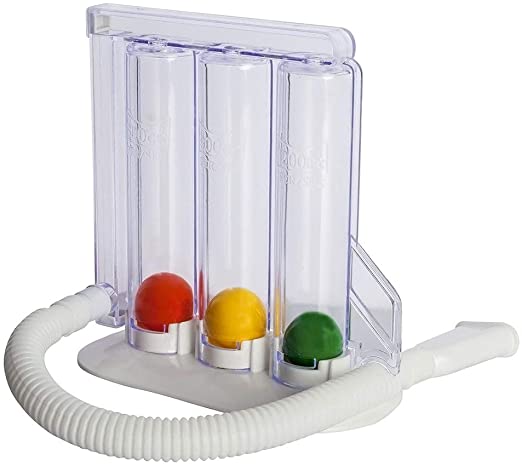
I wish I still had the sense of wonder that my puppy has – instead as I grow older, many things just start feeling ‘sus’. When I first saw an Incentive Spirometer (IS) it sure looked like a scam to me ! Younger patients often say it looks like a bong 🤣 while elder ones feel it’s useless & gimmicky. Of course these days you see a lot more modern / sleeker designs including ones that come with phone apps.
Believe it or not, this device was made after postulating that post-op yawning confered some benefits to patients (we take in a deep breath during a yawn). The main stated benefit of Incentive Spirometry is prevention of post-op pneumonias, atelectasis, hypoxia, avoiding need for ventilation, reducing ICU stay, and improving overall mortality, etc. The myriad of studies done however were not structured well, lack standardization (use 10 times a day or 10 times an hour ?? 🤔 ; volume goal of 1500 cc or 2500 cc ? , etc. ) or confounded due to other things like activity with similar benefits. This wonderful summary paper published in 2018 did a mother of all reviews! – a comprehensive review of reviews and found all the vast evidence wasn’t good enough. It concluded “Perhaps Incentive Spirometry is not effective” but concedes that bad studies, lack of standards & poor patient compliance stand in the way to demonstrate utility. A study in 2019 showed less lung complications after rib fractures, An outpatient study showed 16% increase in lung inspiration volumes in patients undergoing physical therapy, but did not have a control group to compare and since early ambulation, therapies can also make you breath deeper, so cannot say if IS use contributed.
That being said, as a hospitalist, it’s use makes logical sense to me – it is cheap, it makes them cough & expectorate more, deep breathing reduces anxiety and gives patients something harmless to do, makes them sit up more to use it. Advise holding breath for 4 seconds before exhaling. I order IS for all post-op & trauma patients, hypoxic patients, and to stroke & deconditioned patients.
A large barrier to my patients using it is that they simply forget to use it, their minds have ‘bigger fish to fry’. Indeed a study that used a reminder device or using bedside nurses to remind them found improved compliance and lower post-op complications after cardiac surgery. I ask them to aim for the 2500 cc mark and impress me on the next visit (“if you aim for the stars, you can hope to reach the clouds”). Gamifying it improves compliance. Maybe an app reminder on their phones or patient TVs might help ? I also seek family help for reminders for example “hey Julie, your job today is to be the boss & remind Greg to use this every time a commercial pops up on TV !!”
⚠ p.s. : Note a small warning of using IS in patients with severe emphysema.
Don’t miss these fun posts! Subscribe via email 📩 | |
